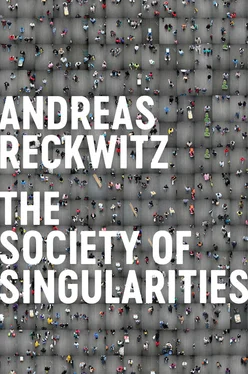Within a social logic of singularities, particularities cannot be reduced to a general schema; rather, they appear unique and are certified as such. Whereas the general-particular designates variations of the same and idiosyncrasy designates pre-social peculiarity, singularity denotes socio-culturally fabricated uniqueness. To begin with, it is possible to define these unique entities in negative terms: as non-generalizable, non-interchangeable, and incomparable. Singular objects, subjects, places, events, and collectives are not merely exemplars of a general order. Stanley Kubrick’s film A Clockwork Orange may admittedly belong to the genre of science fiction, but – in the complexity of its imagery and narration and in its unique tension between fascination and disgust – it cannot be reduced to this or any other type. Cineastes view and experience it as unique. Moreover, a singularity cannot be exchanged for or replaced by a different but functionally identical entity, as readily happens to functional objects and people within the framework of the logic of the general. For those who participated in it, the subculture of mods during the 1960s could not simply be exchanged for another subculture – the rockers, say – but rather developed a subcultural universe of its own with specific practices, symbols, affects, and identities. Finally, a singularity cannot be compared to other entities with any clear parameters, because no overarching standard exists along which it might be possible to measure their differences. To believers, for instance, it would make no sense to compare Shinto’s Ise Grand Shrine to the Church of the Holy Sepulcher in Jerusalem.
On what basis are objects, subjects, places, events, and collectives now fabricated as unique in the social world? The basis is that, over the course of their singularization, these social entities are understood as inherent complexities with inner density . In the logic of singularization – to put this another way – the singular object (be it a work of art or design), the singular subject (a person perceived as unique), the singular place, or the singular collective becomes a “world of its own.” Inherent complexity and inner density are nothing mystical. Complexity, as is well known, denotes a series of elements or nodal points between which there are relations, interconnections, and reciprocal effects. Whenever such a nexus of interrelations exists, one speaks of complexity , whose defining quality can be called density . 6Of course, the type of elements and relations that form a given complexity and determine its density depends on the social entity at hand. An object (such as a painting), a theory, a culinary meal, or a smartphone differs in its composition from a human subject (that entity composed of body and mind), while a physical place (a living-room, a landscape, or a city) consists of elements and relations quite different from those of a temporal entity (such as an event) or a collective (such as a scene, a project, or a nation). Nevertheless, this material variation does nothing to change what singularization means for every social entity: they are constituted as inherent complexities with inner density.
Complexity and density are characteristics of the internal structure of singularities, and this is why I have used the terms inherent complexity and inner density. Singular entities, however, also have a specific relation to the outside . Yet it would be insufficient to claim that there are simply certain differences between them (between the urban logic of Rome and San Francisco, for instance). Of course, difference theory has taught us that, in the socio-cultural realm, it would be impossible to identify any entities at all without the existence of differences, because every entity is constituted in the first place by being different from others. 7Despite its general appeal to cultural theorists, however, it would be a mistake to embrace difference theory fully, for it would bring two serious disadvantages to the analysis of singularities. First, the social relevance of the inherent complexity of entities would be marginalized in favor of the ostensibly ubiquitous “play of differences.” Second, it would raise the risk of losing the capacity to distinguish between the multiplicities of differences that exist in the social world.
It must be stressed that, in the social logic of singularities, differences are certainly identified, but the main issue involves the production and appropriation of inherent complexities. What this means can best be illustrated with an example, for instance American literature. In this case, there are countless ways to identify a difference between the novels of Edith Wharton, John Dos Passos, John Steinbeck, or F. Scott Fitzgerald. Now, if we take the novels of Thomas Pynchon, they are not only unlike the latter; they not only “differentiate themselves” ex negativo from all of them. Rather, in their semantics, syntax, plot structure, characterizations, etc., they develop their own irreducible inner density ex positivo . This inherent complexity stands at the center of singularization in the minds of readers, critics – and the author himself. In contrast to the difference-theoretical primacy of difference over identity, the logic of singularities favors the primacy of inherent complexity over the outward identification of differences.
Within the social logic of singularization, of course, entities also gain their uniqueness by way of their differences, but these have a special form. Whereas, according to difference theory, all cats (differences) are gray at night, the issue now is to distinguish between forms of difference, and to do so according to a social logic. In the social logic of the general, which also identifies differences between its socially relevant entities (objects, subjects, etc.), its focus is on gradual differences of a qualitative or quantitative sort, as I already described above. In an order of singularities, in contrast, differences are always absolutely and without exception qualitative. What prevails here is not rankings but rather a qualitative otherness , which has the character of incommensurability . Incommensurability means that the entities in question lack a common measure; they are not understood as two variants of the same, but rather appear to be incomparable in the strict sense of the word. 8Rome is incommensurable with San Francisco, as is Russia with China, or David Bowie with Van Morrison. The logic of singularization is thus concerned with identifying strong differences .
What happens, however, when the entities of social singularization are compared to one another? As a social practice, the act of comparison did not simply cease with the advent of singularities, and later we will see how, to a considerable extent, the expansion of the social logic of the singular in late modernity led to the creation of new technologies of comparison. 9Comparisons between singularities, which are always inherent complexities, now do exactly what might be expected: they reduce the complexity at hand. In practices of comparison, general parameters are used in order to classify the singularities themselves according to a qualitative or even quantitative standpoint. This means seeing in them only that which fits into the given set of comparative parameters, whereas everything else falls out of view. Notre-Dame Cathedral in Paris and the Doge’s Palace in Venice are thus two examples of Gothic architecture; Christianity and Islam are two monotheistic religions; the album Sgt. Pepper’s Lonely Hearts Club Band sold more copies than the album Blonde on Blonde ; and so on. The schemata of the general therefore reduce the complexities of singularities to a few chosen characteristics that make it possible to draw a comparison between them. Thus, comparisons made within the framework of the social logic of the general differ in a fundamental way from those made within the framework of the social logic of the particular, even if they resemble one another on the surface. A comparison made between entities in the social logic of the general (with various quantifiers or school grades, for instance) serves to represent these entities exhaustively, whereas comparisons made in the social logic of the particular reduce complexity, which does not then disappear but rather – and this is decisive – goes on to function in a structurally formative way (by affecting its recipients, for instance). 10
Читать дальше












